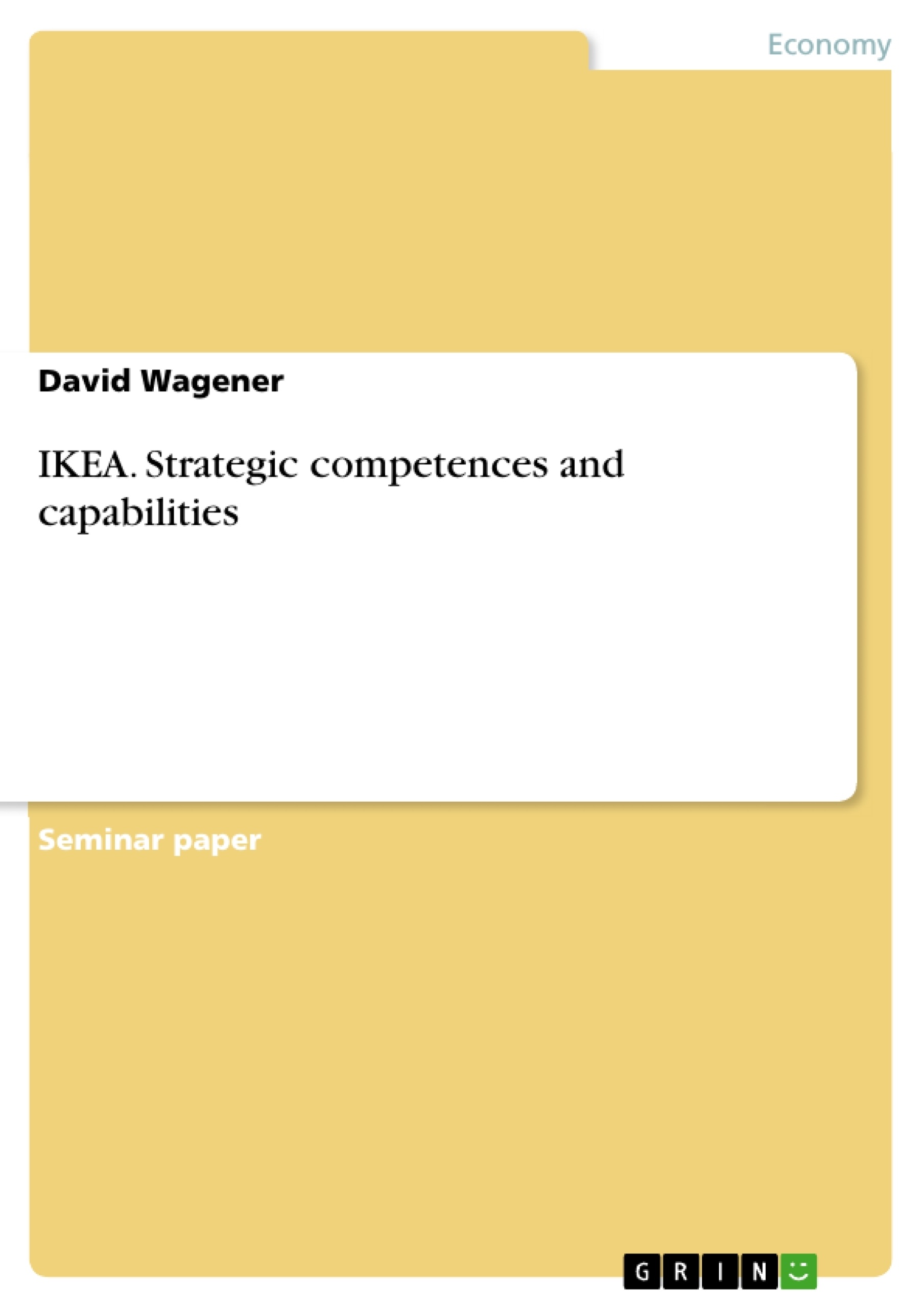Excerpt
Table of Contents
1. Introduction
2. Strategic competences and capabilities
3. IKEA
3.1. IKEA’s dynamic competences and capabilities
3.2. IKEA’s resources, competencies, capabilities
3.3. Integration of knowledge
4. Conclusion and outlook
5. References
1. Introduction
231 stores in 24 countries, 522 million visitors during one year and nearly 20 billion euros in sales make IKEA the most successful furniture retailer in the world (IKEA, 2007; Sloan, 2007). In addition this is achieved without taking advantage of people or the environment, as one of IKEA’s policies is to have an overall positive impact on both (Barner, 2007).
But why is the Sweden-based company so successful? And how did it become that way? Which strategic issues did IKEA face? What are the values, resources and competences the company bases its operations on?
In order to answer these questions this work uses two strategic frameworks. For the historic development of the company the ‘dynamic competence and capability framework’ is used. Furthermore the competitive edge IKEA has in comparison to its concurrence is explained with the ‘static competences and capabilities framework’, which is based on a company’s special set of resources. Within this latter framework there is an emphasis on knowledge as a fundamental resource and on knowledge integration, which is separately discussed.
The remainder of this work is therefore structured as follows. In the second section the frameworks of static and dynamic strategic competences and capabilities are explained. Afterwards, in the third part, the dynamic model is adopted to IKEA by applying it to some of the most important strategic decisions that led to the success of the company. Furthermore this paper is seeking to evaluate IKEA’s current resources, competences and capabilities within the static competence and capability framework. Eventually the integration of knowledge at IKEA is examined. The analysis finishes with a conclusion revising the main points.
2. Strategic competences and capabilities
The discussion of strategic capabilities and competences goes back to a study conducted by Chandler (1992) on the differences in growth of companies since the late 19th century. Chandler argues that manufacturing companies using economies of scale, and thereby reducing the marginal product costs, as wells as the integration of suppliers and retailers in order to ensure the timing of the production process also experience advantageous learning effects. These learning effects are based on the acquisition of “knowledge of customers’ needs and altering product and process to service needs […] and in becoming knowledgeable in the ways of recruiting and training workers and managers.” (Chandler, 1992, p.84)
Grant (1996) states that this knowledge, in combination with other resources, leads to a set of company specific competences, i.e. a special way of performing activities. In case of a steel producer this could, for example, be a very efficient way to melt iron. The strategic capability then is a product of all the competences. Sticking to the example of the steal producer one could think of the production of high-quality steal sold for medium prices. In this work this model is called the ‘static competences and capabilities framework’ (cf. Fig. 1).
illustration not visible in this excerpt
Figure 1: Resources, competences and capabilities in the static framework
Grant (1996) argues further that knowledge is the most valuable resource in today’s economy since it is much harder to copy and therefore more sustainable. One explanation for this is given by Chandler (1992). He describes it as the learnt way of doing business and says it is very dependent on the organizational context they were developed in.
It therefore should, according to Grant (1996), be the main focus of companies to improve their knowledge integration. Furthermore he states
that good integration is worth more than a great amount of special knowledge because the latter is depending on individuals. That is, it is more important to develop a well working process of knowledge integration than to concentrate on accumulating experienced workers. The latter are only a temporary advantage since they can be lured away by competition. However, since most knowledge is special knowledge in the heads of individuals and therefore tacit, i.e. cannot be written down, there can be difficulties with integrating it. The author states three ways it can be done: by directions from the top, by routines and by corporate culture.
Grant also mentions a few factors that influence the integration process. Among these are the breadth of the knowledge, i.e. the number of parts of the organization that are affected by it, and the communication structure of the company. For example it is much easier to integrate new knowledge in a team of 10 employees working as a network than in a whole company with a divisional structure.
Finally Chandler (1996) also refers to the importance of staying adaptive by stating that it is “continous learning that makes a firm’s asset dynamic” (p.98). He hereby anticipates a closely related model of dynamic competences and capabilities by Teece (1997). Teece stresses the point how crucial it is to respond to changing market situations. He therefore extends the former analysis by stating that every company should respond to changes but is only able to do so to the extend that their positions and the resulting path allows it (cf. Fig. 2).[1]
illustration not visible in this excerpt
Figure 2: Positions, paths and dynamic competences in the dynamic framework
[...]
[1] The components of the model are explained in more detail in the analysis of IKEA in the third section.
- Quote paper
- David Wagener (Author), 2008, IKEA. Strategic competences and capabilities, Munich, GRIN Verlag, https://www.grin.com/document/113429
Publish now - it's free






















Comments